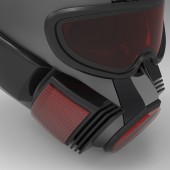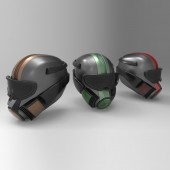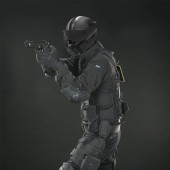DESIGN NAME:
Intelligente
PRIMARY FUNCTION:
Helmet
INSPIRATION:
Bringing together students from diverse areas such as engineering, neuroscience, and design, we hoped to develop new ways for humans to interact with artificial systems. We consider law enforcement, because it is a high stress environment that may benefit from improved
human-computer interactions. Drawing on the expertise of our group, we developed a concept, grounded in science and engineering, for monitoring the physiological signals of these individuals while providing visual feedback.
UNIQUE PROPERTIES / PROJECT DESCRIPTION:
The possible applications of wearable interfaces capture the imagination, yet even as they pervade movies and popular culture, there are very few examples of practical systems outside of research laboratories. The challenge is to design wearable interfaces that utilize newly developed technologies in appropriate ways. Here we present a helmet that draws on emerging technologies to provide a wearable brain-computer interface and visual feedback system for law enforcement.
OPERATION / FLOW / INTERACTION:
Imagine an officer entering a stressful or dangerous situation. As he or she investigates, sensors continuously collect and report signals generated within their own bodies. Simultaneously, this data is shared with other supporting officers. Changes in sensor readings
would alert individuals to change their behavior, react to their colleagues, or be aware of shifts in their environment. In the event of injury, the sensors will be able to report relevant medical information to the nearest aid.
PROJECT DURATION AND LOCATION:
The core group of students working on this project have been gathering since January of 2013 at the University of Illinois Urbana-Champaign School of Art and Design.
|
PRODUCTION / REALIZATION TECHNOLOGY:
Recent advances in psychophysiological recording and the miniaturization of displays make this helmet concept feasible. These key technologies are concurrently supported by advancements in low-cost computing and wireless communication. The form factor of this design
was chosen to allow for the seamless integration of these technologies into the helmet without hindering the performance of the law enforcement officer.
SPECIFICATIONS / TECHNICAL PROPERTIES:
400mm x 300mm
TAGS:
Brain Computer Interface, Electrodes, EEG, Law Enforcement, Police Officer
RESEARCH ABSTRACT:
This project aimed to develop a combined brain-machine interface and visual feedback system for law enforcement officers. Previous scientific research has shown that it is possible to record, classify, and display neural signals in real-time using wearable interfaces. The results of these studies were integrated into the helmet design. Final renderings were produced in Solid Works, highlighting the potential of biosignal monitoring and feedback for law enforcement officers.
CHALLENGE:
The application of psychophysiological monitoring to wearable devices is still in its infancy. To design such a device, one must predict how technology will evolve. By designing for the future, we guide the engineering necessary to implement the system. This, in turn, drives scientific questions that help us understand the physiological responses of people to their environment. This improved understanding then motivates design revisions to help us better meet the requirements of these users.
ADDED DATE:
2014-02-25 23:04:50
TEAM MEMBERS (6) :
Cliff Shin, James Norton, Erik Johnson, Shan Wei, Michelle Kwak and Zhenmin Li
IMAGE CREDITS:
Cliff Shin, 2013.
|









